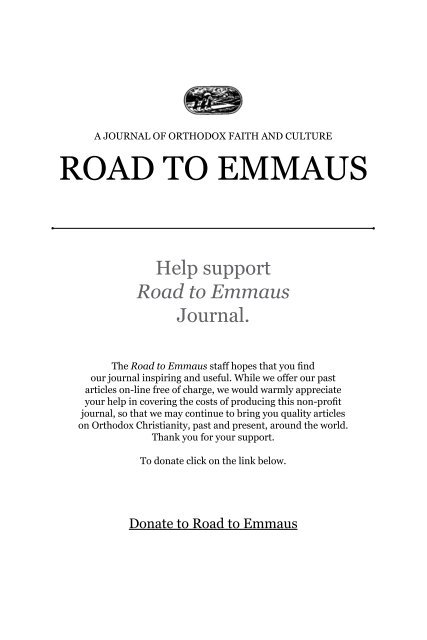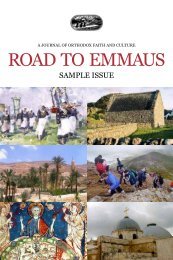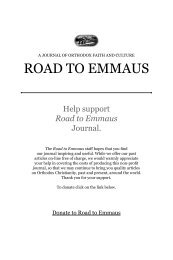A Short History of Finnish Orthodoxy - Road to Emmaus Journal
A Short History of Finnish Orthodoxy - Road to Emmaus Journal
A Short History of Finnish Orthodoxy - Road to Emmaus Journal
You also want an ePaper? Increase the reach of your titles
YUMPU automatically turns print PDFs into web optimized ePapers that Google loves.
A JOURNAL OF ORTHODOX FAITH AND CULTURE<br />
<strong>Road</strong> <strong>to</strong> <strong>Emmaus</strong><br />
Help support<br />
<strong>Road</strong> <strong>to</strong> <strong>Emmaus</strong><br />
<strong>Journal</strong>.<br />
The <strong>Road</strong> <strong>to</strong> <strong>Emmaus</strong> staff hopes that you find<br />
our journal inspiring and useful. While we <strong>of</strong>fer our past<br />
articles on-line free <strong>of</strong> charge, we would warmly appreciate<br />
your help in covering the costs <strong>of</strong> producing this non-pr<strong>of</strong>it<br />
journal, so that we may continue <strong>to</strong> bring you quality articles<br />
on Orthodox Christianity, past and present, around the world.<br />
Thank you for your support.<br />
To donate click on the link below.<br />
Donate <strong>to</strong> <strong>Road</strong> <strong>to</strong> <strong>Emmaus</strong>
A <strong>Short</strong><br />
<strong>His<strong>to</strong>ry</strong> <strong>of</strong><br />
the <strong>Finnish</strong><br />
Orthodox<br />
Church<br />
Orthodox Christianity first spread <strong>to</strong> eastern Finland from Novgorod over<br />
a thousand years ago through monks and traders. Monasteries founded<br />
on the islands <strong>of</strong> Lake Ladoga contributed significantly <strong>to</strong> the establishment<br />
<strong>of</strong> the Orthodox faith in eastern Finland and Russia, chief among them being<br />
Valaam, founded by a Greek-born monk, St. Sergius, and a local Karelian,<br />
St. Herman. Other important monasteries were Konevitsa, founded in the<br />
14th century by another Greek monastic, St. Arsenius, and Petsamo (Pechenga)<br />
near the Arctic Ocean, a 16th century foundation <strong>of</strong> St. Tryphon <strong>of</strong><br />
Novgorod, who converted the Skolt Sami Lapps. By the end <strong>of</strong> the 16th-century,<br />
village churches and small wilderness monasteries flourished throughout<br />
the region.<br />
Some <strong>of</strong> the earliest traces <strong>of</strong> Christianity in Finland are <strong>of</strong> Orthodox<br />
Christian origin. Excavated crosses found in Finland date <strong>to</strong> the 11th century,<br />
and are similar <strong>to</strong> a type found in Novgorod and Kiev, and most <strong>Finnish</strong><br />
Christian words appear <strong>to</strong> be loans from an early East Slavic language, which<br />
in turn borrowed them from Greek. Central and western <strong>Finnish</strong> peoples<br />
participated less in this Orthodox tradition, being primarily converted by<br />
Roman Catholic missionaries from Sweden.<br />
All <strong>of</strong> these early monasteries were destroyed in 16th and 17th century<br />
wars, in the course <strong>of</strong> which parts <strong>of</strong> western Karelia were incorporated in<strong>to</strong><br />
Opposite: Uusi (New) Valamo Monastery, Church <strong>of</strong> the Transfiguration <strong>of</strong> Christ.<br />
21
<strong>Road</strong> <strong>to</strong> <strong>Emmaus</strong> Vol. IX, No. 4 (#35)<br />
A <strong>Short</strong> <strong>His<strong>to</strong>ry</strong> <strong>of</strong> the <strong>Finnish</strong> Orthodox Church<br />
the Kingdom <strong>of</strong> Sweden. The Lutheran Swedes pressured the local Orthodox<br />
population <strong>to</strong> convert, and many Orthodox Karelians moved <strong>to</strong> central Russia<br />
at this time. When the terri<strong>to</strong>ries around Lake Ladoga were recaptured<br />
by Peter the Great in the early 18th century, the Orthodox Church regained<br />
its status in the area, and the monasteries <strong>of</strong> Valaam and Konevitsa were<br />
rebuilt on their his<strong>to</strong>ric sites. In 1809 the whole <strong>of</strong> Finland was attached<br />
<strong>to</strong> the Russian Empire as an au<strong>to</strong>nomous Grand Duchy, and the Orthodox<br />
population increased ten-fold. The northern monastery <strong>of</strong> Petsamo was reestablished<br />
at the end <strong>of</strong> the 19th century, and a Karelian women’s monastery<br />
was founded, which is now Lintula Convent. The Christians <strong>of</strong> central<br />
and western Finland continued their allegiance <strong>to</strong> the Lutheran state church,<br />
while Karelia regained and strengthened its <strong>Orthodoxy</strong> as part <strong>of</strong> the larger<br />
Grand Duchy <strong>of</strong> Russia.<br />
From early times, the Orthodox Church in Finland was administratively<br />
under the Archbishop <strong>of</strong> Novgorod, but when Finland was annexed by Russia<br />
in the 18th century, local parishes were joined <strong>to</strong> the Diocese <strong>of</strong> St. Petersburg.<br />
In the late 18th and mid-19th centuries, the Russian Orthodox Church<br />
made great efforts <strong>to</strong> catechize the Orthodox populations in these border regions<br />
and remote areas, and the Russian Holy Synod decreed that services in<br />
<strong>Finnish</strong> parishes should be conducted in <strong>Finnish</strong>. In 1892, a separate church<br />
administration for Finland was set up under the Diocese <strong>of</strong> St. Petersburg,<br />
and in 1892 this became the independent Diocese <strong>of</strong> Finland and Viipuri<br />
(Vyburg), serving Russians, Finns and the Skolt-Sami Laplanders.<br />
Finland gained its independence as a result <strong>of</strong> the Russian Revolution, and<br />
in 1918, the <strong>Finnish</strong> Senate <strong>of</strong>ficially named the Orthodox Church as Finland’s<br />
second state church, equal in rights <strong>to</strong> the Lutheran Church. Patriarch<br />
Tikhon <strong>of</strong> Russia confirmed the au<strong>to</strong>nomy <strong>of</strong> the Orthodox Church <strong>of</strong> Finland<br />
in 1921. Because <strong>of</strong> political turmoil and the difficulty <strong>of</strong> maintaining<br />
contact with the Soviet-persecuted Russian Church, the Orthodox Church <strong>of</strong><br />
Finland was accepted under the protection <strong>of</strong> the Ecumenical Patriarchate <strong>of</strong><br />
Constantinople in 1923, which continues <strong>to</strong> confirm the election <strong>of</strong> Finland’s<br />
archbishops. When the Ecumenical Patriarchate adopted the Gregorian calendar<br />
in that same year, the <strong>Finnish</strong> Orthodox Church did so as well.<br />
The Second World War turned the Orthodox Church <strong>of</strong> Finland in<strong>to</strong> a<br />
church <strong>of</strong> refugees. After the Winter War <strong>of</strong> 1939-40, Finland was obliged<br />
<strong>to</strong> cede Sortavala and all <strong>of</strong> Ladoga Karelia <strong>to</strong> the Soviet Union. The <strong>Finnish</strong><br />
Orthodox Church lost 90% <strong>of</strong> its property, and 70% <strong>of</strong> its members were<br />
evacuated from their homes. The Orthodox refugee population <strong>of</strong> 400,000<br />
was dispersed throughout Finland, and the monasteries <strong>of</strong> Karelia were refounded<br />
at new locations. Valaam Monastery on Lake Ladoga was among<br />
those evacuated, and the monastery <strong>of</strong> New Valamo was founded in 1941 at<br />
Heinävesi, on the <strong>Finnish</strong> side <strong>of</strong> the new border. Later, monks from Konevitsa<br />
and Petsamo monasteries joined the monks at New Valamo, and by<br />
the 1970s, <strong>Finnish</strong> novices began <strong>to</strong> arrive. Nuns from the Lintula Holy Trinity<br />
Convent at Kivennapa (Karelian Isthmus) re-established their convent<br />
near New Valamo in Heinävesi in 1946. With the fall <strong>of</strong> communism, Old<br />
Valaam monastery on Lake Ladoga was re-established in Russian Karelia<br />
in 1989, followed by the monasteries <strong>of</strong> Konevitsa (Konevitz) and Petsamo<br />
(Pechenga). The two Valamo foundations in Russia and Finland maintain<br />
brotherly relations.<br />
The founding <strong>of</strong> new parishes throughout Finland began in the 1950s and<br />
<strong>to</strong>day the <strong>Finnish</strong> Orthodox Church has 62,000 members and is growing<br />
steadily. <strong>Finnish</strong> Orthodox Christians worship within the three dioceses <strong>of</strong><br />
Karelia, Helsinki, and Oulu. These dioceses are further broken down in<strong>to</strong> 25<br />
parishes that administer Finland’s 125 churches and chapels.<br />
22<br />
23










